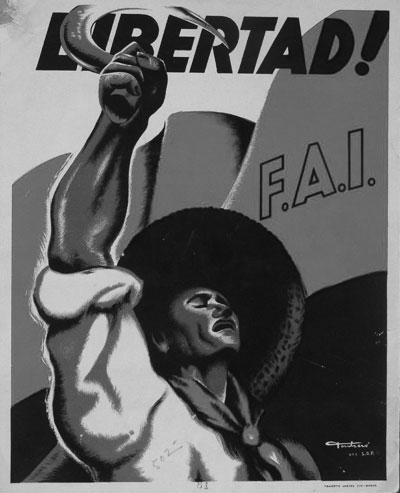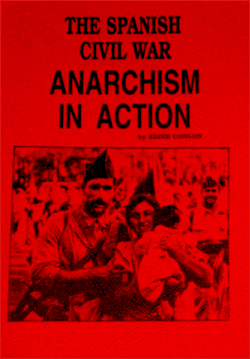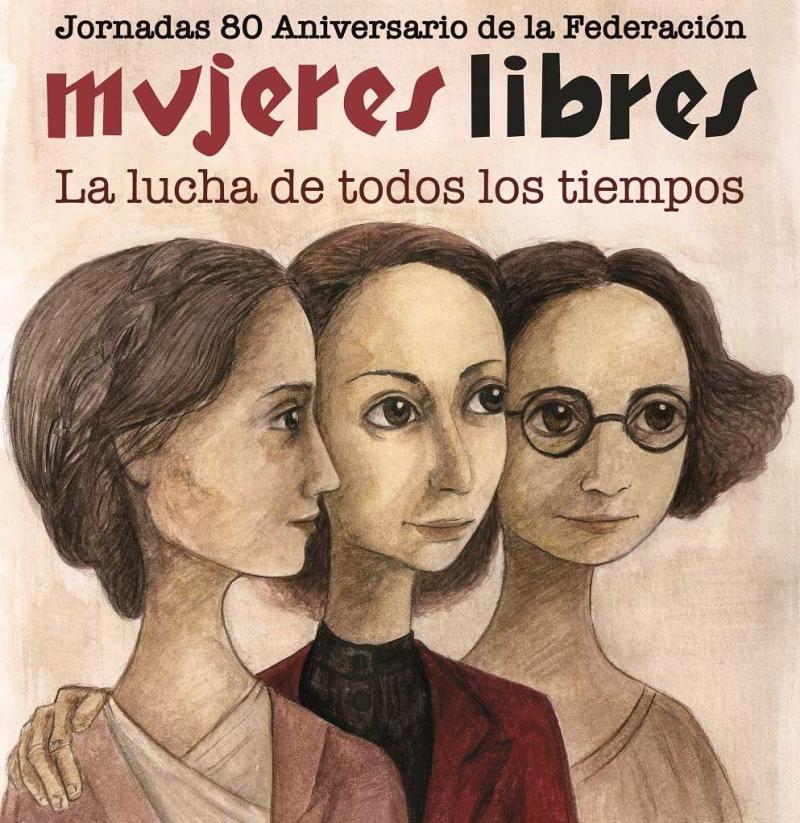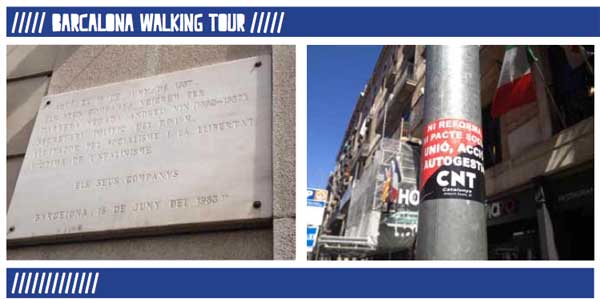Over 30 years of anarchist writing from Ireland listed under hundreds of topics
Spanish revolution
What We Believe - WSM Points of Unity Explained (Audio)
This is a series explaining the 9 Points of Unity of the Workers Solidarity Movement - an anarchist organisation active on the island of Ireland. [Download PDF of these explanations]
The WSM regularly discusses, debates and decides on what our collective political approach is. The Points of Unity are the most basic political agreement necessary to be a WSM member or supporter. They are 9 short points which outline the anarchism the WSM stands for.
The Spanish Revolution: A quick introduction
 The 19th of July marked the 75th anniversary of the beginning of the Spanish Revolution. For a brief time, capitalism and the State were replaced by solidarity, mutual aid and respect for others. Workers and peasants, who were deeply influenced by anarchist ideas, ran society collectively and gained control over their lives, industry and land. A central part of the revolution was the struggle against a fascist attempt to take over Spain. We remember both the magnificent triumphs and tragedies of the Spanish revolution and attempt to learn from our comrades’ mistakes.
The 19th of July marked the 75th anniversary of the beginning of the Spanish Revolution. For a brief time, capitalism and the State were replaced by solidarity, mutual aid and respect for others. Workers and peasants, who were deeply influenced by anarchist ideas, ran society collectively and gained control over their lives, industry and land. A central part of the revolution was the struggle against a fascist attempt to take over Spain. We remember both the magnificent triumphs and tragedies of the Spanish revolution and attempt to learn from our comrades’ mistakes.
The Spanish Civil War: Anarchism in Action
 A detailed introduction to the role anarchism played in the Spanish Civil War and the anarchist revolution within the republican zone.
A detailed introduction to the role anarchism played in the Spanish Civil War and the anarchist revolution within the republican zone.
Much has been written about the Spanish Civil War but the contribution of the Anarchists has been either totally ignored or reduced to a few footnotes which were often composed of blatant lies. To set the record straight this pamphlet was produced. It is not a history of the Civil War, that would require many hundreds of pages to do justice to the subject. It is an uncovering of the "hidden history" of the Anarchist participation in Spain's anti-fascist struggle.
The anarchist masses threw themselves into a fight against fascism, and its cause, capitalism. Unfortunately the revolution was not complete, the CNT leaders held it back. Indeed their behaviour highlights the effect that power can have on even those who lay claim to anarchism. Spain provided important lessons for anarchists.
The revolutionary message of the 'Friends of Durruti'
 The Spanish anarchist organization 'The Friends of Durruti' was formed by members of the CNT in 1937 in opposition to the collaboration of the CNT leadership in the government of Republican Spain. The first heavily censored issue of their paper 'Friend of the People' appeared just after the Mayday's in Barcelona, sections of it are reproduced for the first time in English in this pamphlet. The Mayday defense of the revolution in Barcelona was crushed at the cost of 500 lives, including the disappearance, torture and murder of key anarchist organisers by the stalinists. The Friends of Durruti outlined an alternative path for Spanish anarchists, one intended to not only protect but to expand the revolution and bring it to victory.
The Spanish anarchist organization 'The Friends of Durruti' was formed by members of the CNT in 1937 in opposition to the collaboration of the CNT leadership in the government of Republican Spain. The first heavily censored issue of their paper 'Friend of the People' appeared just after the Mayday's in Barcelona, sections of it are reproduced for the first time in English in this pamphlet. The Mayday defense of the revolution in Barcelona was crushed at the cost of 500 lives, including the disappearance, torture and murder of key anarchist organisers by the stalinists. The Friends of Durruti outlined an alternative path for Spanish anarchists, one intended to not only protect but to expand the revolution and bring it to victory.
Industrial Collectivisation during the Spanish Revolution
 Within hours of the start of the Spanish revolution workers had seized control of 3000 enterprises. This included all public transportation services, shipping, electric and power companies, gas and water works, engineering and automobile assembly plants, mines, cement works, textile mills and paper factories, electrical and chemical concerns, glass bottle factories and perfumeries, food processing plants and breweries. (Image: Public transport was one of the first industries to be collectivised)
Within hours of the start of the Spanish revolution workers had seized control of 3000 enterprises. This included all public transportation services, shipping, electric and power companies, gas and water works, engineering and automobile assembly plants, mines, cement works, textile mills and paper factories, electrical and chemical concerns, glass bottle factories and perfumeries, food processing plants and breweries. (Image: Public transport was one of the first industries to be collectivised)
Mujeres Libres - Free Women of Spain
 Conditions for the vast majority of people in Spain in the 1920s and 1930s were appalling. For women they were especially bad. There were extreme gender divisions. Most women were economically dependent on men. Household chores and childcare were exclusively women's domain. In both countryside and city women's wages were lower than men's. For example the average daily wage of a male agricultural labourer was 3 pesetas while a women got just half this, for working from dawn to dusk.
Conditions for the vast majority of people in Spain in the 1920s and 1930s were appalling. For women they were especially bad. There were extreme gender divisions. Most women were economically dependent on men. Household chores and childcare were exclusively women's domain. In both countryside and city women's wages were lower than men's. For example the average daily wage of a male agricultural labourer was 3 pesetas while a women got just half this, for working from dawn to dusk.
The Anarchist Collectives in the Countryside during the Spanish Civil War
Many people, upon hearing about Anarchism, consider a society based on anarchist principles as unrealistic, idealistic and naive - the vision of dreamers. Given the homogenous view of the world represented in the media, it is often difficult for people to imagine a society where such universally accepted institutions as the state, the judiciary system, the police, armies, and nations no longer exist.
Video - Living Utopia - The Anarchists and the Spanish Revolution
This documentary has interviews with 30 anarchist participants in the Spanish revolution alongside footage captured at that time. [Video]
"Living Utopia is a unique documentary that blends the historical account of the origins and development of the Spanish anarchist movement, focussing on the 1936 war. A reflection on the philosophical underpinnings of such a movement and their practical application. As both an informative and inspiring piece of research it is considered a jewel amongst historians and rebel hearts.
Kurdish version of A Las Barricadas released to mark anniversaries of Spanish and Rojava revolutions today, July 19th
To mark todays 80th anniversary of the Spanish revolution and what is also the 4th anniversary of the Rojava revolution in Kobane this recording of a Kurdish version of A Las Barricadas has just been released.
It's recorded in Qamişlo, Rojava by members of the Mohamed Şêxo art and culture centre. The performers say "What happened in Barcelona on 19th July 1936 was repeated 76 years later. We started in Kobanê, and it was there that we put up our fiercest resistance. Countless comrades have fallen to defend this city against the fascists, just like the countless comrades who gave their live to defend the revolution in Catalonia and Spain.
Shadows of a revolution - Nick Lloyd's Spanish civil war walking tour reviewed
Ask an anarchist for an example of a time and place where their ideas were put to the test and they will most likely reply with “Barcelona, 1936”. In July of that year, the workers of Barcelona, mainly organised around the anarcho-syndicalist Confederación Nacional del Trabajo (CNT; "National Confederation of Labour") rose in opposition to the fascist generals' coup that was gripping the south of the Spanish state.


